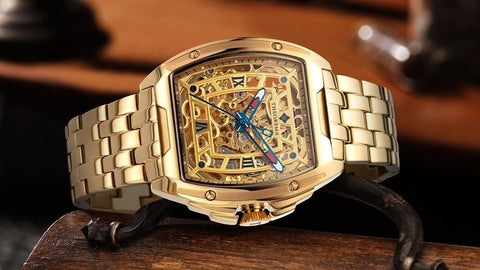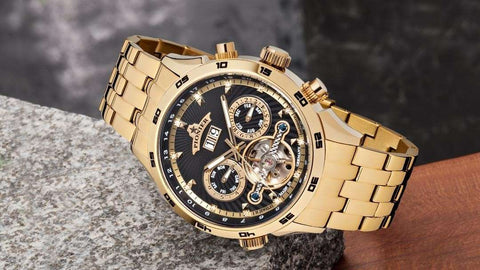For good reason, luxury plated jewelry is among the most sought-after items available in the market. Fashionable, durable and extremely attractive, these accessories have always been quite popular among watch collectors and enthusiasts. If you prefer the shine and luster of gold and you’re searching for a new watch, IPG gold-plated watches are a great option! In this blog post, we’ll go into greater detail about these timepieces, providing a thorough overview of their benefits, robustness, and upkeep.
Tufina Theorema St. Petersburg GM-121-7 Gold.
What is gold plating?
Gold plating is the process of covering a substrate or base metal with a layer of real gold. This method is frequently used to create gold-plated watches, bracelets, necklaces, and earrings. One particular type of gold plating that is non-allergic, highly durable, and corrosion-resistant is called IPG gold plating. The layer of gold can be applied in several ways. Microns are used to measure the thickness of the gold coating; a greater number corresponds to more gold being deposited. Gold plating enhanced the look and robustness of jewelry, especially watches, shielding them from tarnish and damage. A common base metal for gold-plated watches is stainless steel, and the typical plating layer is 18k gold. But at Tufina, we like 22k gold better because of its better gloss and luster.
How does gold plating work?
A number of procedures are involved in the gold plating process to guarantee a spotless and even surface for the metallic coating. Sandblasting or any other suitable technique must first be used to remove any impurities or undesired dents from the watch casing. After that, the surface is thoroughly cleaned using a degreasing solution. After a thorough rinsing, the casing is now clear of any remaining residue and grime. A base coat, which serves as a final primer, is next applied. Lastly, a layer of gold is applied to the watch casing in accordance with the manufacturer's instructions.
To make sure that the plating is applied evenly and that no residue is left behind, a final rinse is carried out. A robust and eye-catching watch case with gold plating showcases all the aesthetic qualities of gold along with its resistance to tarnish and rust. Final polishing produces a high gloss surface. The intricate process of gold plating necessitates a high degree of engineeringcomprehension, precision, and attention to detail.
Tufina Pionier Florida Diamonds GM-505-8 Gold.
What is the purpose of gold plating?
To put it technically, gold plating is used to improve the metal parts of a watch. It is utilized to greatly increase the watch's resistance to corrosion while also providing it a whole new look and increased value in terms of elegance and style. Highly conductive and resistant to tarnish and corrosion, real gold is a durable material. Gold plating, when paired with stainless steel, results in extremely robust timepieces that are well worth their cost. In addition to its decorative function, plating gives the finished product a touch of glitz and elegance. The objective is still to produce long-lasting, superior watch parts that will not fade in terms of functionality or style, even if gold plating technology has evolved dramatically over time. To put it another way, gold plating guarantees that your gear performs and looks its best.
Additionally, gold plating offers defense against environmental factors like oxygen, toxins, and humidity. The thickness of the gold payer may vary from a few microns to several micrometers, depending on the application. Gold plating is unquestionably crucial to many industries, including the production of high-end watches, as it offers a number of advantages to improve the products' performance and quality.
The economic benefits of gold plated watches
Gold-plated watches offer a stylish, high-end quality option for people who love gold accessories. While the cost of 1 gram of 18k gold can exceed $2000, gold-plated timepieces remain relatively affordable compared to solid gold watches. Buying a watch made solely of gold could set you back thousands of dollars, a choice that is not only impractical but also not recommended for those looking for a durability in a timepiece (we'll delve into this later). Moreover, plated watches allow watchmakers to experiment with diverse designs, offering consumers a broad selection of timepieces spanning various styles.
Selecting a gold-plated watch over a solid gold one is not only economical, but also a smart move. This is so because watches made of solid gold are not as durable as jewelry that is plated in gold. Even though solid gold is strong, it can still get scratches if not handled carefully. Choosing a watch with a robust 316L stainless steel case and an exquisite gold band gives you the best of both worlds in terms of appearance and durability. Furthermore, because solid gold is so difficult to deal with, jewelry made of it is typically only offered in straightforward forms. For watch designers, this means that gold plating offers up a whole new universe of options.
What metals work best with gold plating?
A multitude of metals, including brass, copper, nickel, and stainless steel, can be coated with IPG gold plating. The substrate surface's properties, however, determine how effective the coating is. For example, copper is a desirable material to use for gold plating because of its great conductivity and uniform consistency. Conversely, nickel is more difficult to plate. It has a tendency to oxidize and create a passivating coating that prevents gold from adhering. As a result, certain pre-treatment techniques like etching, activation, or de-passivation could be required to provide a finish that is both long-lasting and attractive.
Tufina Theorema Copacabana GM-108-8 Gold.
What factors influence the amount of gold used in gold plating?
The intended thickness and overall purpose determine how much gold is needed in the plating process. For instance, the amounts of gold used in various plating techniques, such as electroplating and electroless plating, vary. Furthermore, compared to gold-plated timepieces, gold-plated earrings will require less gold overall. Lastly, the amount of gold used in plating might vary greatly because watch manufacturers have different specifications for the number of microns they want in their gold-plated watches.
Are gold plated watches high-quality?
In the jewelry industry, 2.5 micron plating is typically considered standard. Because it strikes a pleasing balance between thickness and appearance, it is a popular option among producers. Since gold ions aid in plating, the quantity of ions supplied to the plating solution directly correlates with the coating quality. Your watch's beauty will be preserved and appropriate protection against wear and tear will be provided by its 2.5–5 micron thickness. Well-made timepieces with gold plating are strong enough to hold their beauty for a long time, even after frequent usage. As long as you take good care of it and attempt to prevent unintentional drops, a gold-plated watch will offer the perfect amount of elegance, robustness, and quality. It will last for years.
Tufina Theorema Lagos GM-113-9 Gold.
What colors can be achieved with gold plating?
Different methods and gold content can be used by watchmakers to achieve various color subtleties. The final result is greatly influenced by the thickness of the plating, which enables the development of darker to lighter gold tones. The watch will have a darker, more mirror-like sheen the thicker the plating. On the other hand, a brighter, more metallic appearance is possible with thinner platings. To produce unique gold hues for certain patterns, some specific gold coating methods employ various coloration treatments. Consequently, selecting the appropriate plating color might be crucial to maximizing the watch's visual attractiveness and aesthetic appeal.
How to take care of gold plated watches?
You must understand how to properly care for your gold-plated watch if you want to maintain its quality and beauty. Even after many years of usage, gold-plated watches can maintain their beautiful appearance with proper care. Above all, make every effort to keep your watch away from any salted water. Chlorine can accelerate the deterioration of your gold plating. Recall that your sophisticated gold-plated watch is not intended for diving, so don't let it come into contact with saline water!
Secondly, be sure you understand the correct way to clean it. Try to develop the habit of cleaning your watch after each use, just like you should with any other kind of jewelry. Make use of a jeweler or soft cloth. You can use a damp cloth and a few drops of mild soap to gently clean your watch if you find that it has accumulated dirt. Mild baby soap should work just fine; avoid using harsh cleaning agents or vigorous rubbing! After that, you should gently dry the watch with a soft, lint-free cloth until you see that its shine has returned.
Check out our selections if you're searching to get a high-end gold-plated watch! We have a large selection of IPG plated 22k gold watches for men that promise exceptional craftsmanship and stunning designs!











Leave a comment